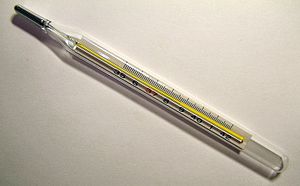
Febrile seizure

A febrile seizure, also known as a fever fit or febrile convulsion, is a seizure associated with a high body temperature but without any serious underlying health issue. They most commonly occur in children between the ages of 6 months and 5 years. Most seizures are less than five minutes in duration and the child is completely back to normal within an hour of the event. Febrile seizures may run in families. The diagnosis involves verifying that there is not an infection of the brain, there are no metabolic problems, and there have not been prior seizures that have occurred without a fever. There are two types of febrile seizures: simple febrile seizures and complex febrile seizures. Simple febrile seizures involve an otherwise healthy child who has at most one tonic-clonic seizure lasting less than 15 minutes in a 24-hour period. Blood testing, imaging of the brain or an electroencephalogram (EEG) is typically not needed for the diagnosis. Examination to determine the source of the fever is recommended. In otherwise healthy-looking children a lumbar puncture is not necessarily required. Neither anti-seizure medication nor anti-fever medication are recommended in an effort to prevent further simple febrile seizures. In the few cases that last greater than five minutes a benzodiazepine such as lorazepam or midazolam may be used. Outcomes are generally excellent with similar academic achievements to other children and no change in the risk of death for those with simple seizures. There is tentative evidence that affected children have a slightly increased risk of epilepsy at 2%. Febrile seizures affect two to five percent of children before the age of five. They are more common in boys than girls. After a single febrile seizure there is a 15 to 70% chance of another one. During generalized febrile seizures, the body will become stiff and the arms and legs will begin twitching. The child loses consciousness, although their eyes remain open. Breathing can be irregular. They may become incontinent (wet or soil themselves); they may also vomit or have increased secretions (foam at the mouth). The seizure normally lasts for less than five minutes. The child's temperature is usually greater than 38 °C (100.4 °F). Febrile seizures are due to fevers, usually those greater than 38 °C (100.4 °F). The cause of the fevers is often a viral illness. The likelihood of a febrile seizure is related to how high the temperature reaches. Some feel that the rate of increase is not important while others feel the rate of increase is a risk factor. This latter position has not been proven. There is a small chance of a febrile seizure after certain vaccines. Implicated vaccines include measles/mumps/rubella/varicella, diphtheria/tetanus/acellular pertussis/polio/Haemophilus influenzae type b, whole-cell pertussis, some versions of the pneumococcal vaccine, and some types of influenza vaccine when given together with the pneumococcal vaccine or diphtheria/tetanus/acellular pertussis vaccine. The seizures occur, by definition, without an intracranial infection or metabolic problems. They run in families. Several genetic associations have been identified. An association with iron deficiency has also been reported, particularly in the developing world. The diagnosis is arrived at by eliminating more serious causes of seizure and fever: in particular, meningitis and encephalitis. However, in locales in which children are immunized for pneumococcal and Haemophilus influenzae, the prevalence of bacterial meningitis is low. If a child has recovered and is acting normally, bacterial meningitis is very unlikely.
